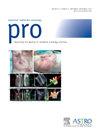Centralized Quality Assurance of Stereotactic Body Radiation Therapy for the Veterans Affairs Cooperative Studies Program Study Number 2005: A Phase 3 Randomized Trial of Lung Cancer Surgery or Stereotactic Radiotherapy for Operable Early-Stage Non-Small Cell Lung Cancer (VALOR)
IF 3.4
3区 医学
Q2 ONCOLOGY
引用次数: 0
Abstract
Purpose
The phase 3 Veterans Affairs Lung Cancer Surgery Or Stereotactic Radiotherapy study implemented centralized quality assurance (QA) to mitigate risks of protocol deviations. This report summarizes the quality and compliance of the first 100 participants treated with stereotactic body radiation therapy (SBRT) in this study.
Methods and Materials
A centralized QA program was developed to credential and monitor study sites to ensure standard-of-care lung SBRT treatments are delivered to participants. Requirements were adapted from protocols established by the National Cancer Institute's Image and Radiation Oncology Core, which provides oversight for clinical trials sponsored by the National Cancer Institute's National Clinical Trials Network.
Results
The first 100 lung SBRT treatment plans were reviewed from April 2017 to October 2022. Tumor contours were appropriate in all submissions. Planning target volume (PTV) expansions were less than the minimum 5 mm requirement in 2% of cases. Critical organ-at-risk structures were contoured accurately for the proximal bronchial tree, trachea, esophagus, spinal cord, and brachial plexus in 75%, 92%, 100%, 100%, and 95% of cases, respectively. Prescriptions were appropriate in 98% of cases; 2 central tumors were treated using a peripheral tumor dose prescription while meeting organ-at-risk constraints. PTV V100% (the percentage of target volume that receives 100% or more of the prescription) values were above the protocol-defined minimum of 94% in all but 1 submission. The median dose maximum (Dmax) within the PTV was 125.4% (105.8%-149.0%; SD ± 8.7%), where values reference the percentage of the prescription dose. High-dose conformality (ratio of the volume of the prescription isodose to the volume of the PTV) and intermediate-dose compactness [R50% (ratio of the volume of the half prescription isodose to the volume of the PTV) and D2cm (the maximum dose beyond a 2 cm expansion of the PTV expressed as a percentage of the prescription dose)] were acceptable or deviation acceptable in 100% and 94% of cases, respectively.
Conclusions
The first 100 participants randomized to SBRT in this study were appropriately treated without safety concerns. A response to the incorrect prescriptions led to preventative measures without further recurrences. The program was developed in a health care system without prior experience with a centralized radiation therapy QA program and may serve as a reference for other institutions.
退伍军人事务合作研究计划研究编号 2005:立体定向体外放射治疗的集中质量保证:肺癌手术或立体定向放疗治疗可手术早期非小细胞肺癌的 3 期随机试验 (VALOR)。
背景:退伍军人事务部肺癌手术或立体定向放射治疗(VALOR)III 期研究实施了集中质量保证(QA),以降低方案偏差风险。本报告总结了在该研究中接受 SBRT 治疗的前 100 名参与者的质量和依从性:方法:制定了一项集中质量保证计划,对研究机构进行认证和监督,以确保为参与者提供符合标准的肺部立体定向体放射治疗(SBRT)。这些要求改编自美国国立癌症研究所图像与放射肿瘤学核心制定的协议,该核心负责监督由美国国立癌症研究所国家临床试验网络赞助的临床试验:从2017年4月到2022年10月,对首批100例肺SBRT治疗计划进行了审查。所有提交的肿瘤轮廓均合适。2%的病例的PTV扩展小于最低5毫米的要求。75%、92%、100%、100% 和 95% 的病例中,近端支气管树、气管、食管、脊髓和臂丛的关键风险器官 (OAR) 结构轮廓准确。在 98% 的病例中,处方都是适当的;有两个中心肿瘤在满足 OAR 限制的情况下,使用外周肿瘤剂量处方进行了治疗。除一个病例外,其他所有病例的 PTV V100% 值都高于方案定义的最低值 94%。PTV内Dmax的中位数为125.4%(105.8% - 149.0%,标准偏差±8.7%)。高剂量符合性(结论:本研究中随机接受 SBRT 治疗的前 100 名参与者均接受了适当的治疗,没有出现安全问题。针对错误处方采取了预防措施,没有再发生复发。该计划是在一个没有集中 RT QA 计划经验的医疗系统中制定的,可为其他机构提供参考。
本文章由计算机程序翻译,如有差异,请以英文原文为准。
求助全文
约1分钟内获得全文
求助全文
来源期刊

Practical Radiation Oncology
Medicine-Radiology, Nuclear Medicine and Imaging
CiteScore
5.20
自引率
6.10%
发文量
177
审稿时长
34 days
期刊介绍:
The overarching mission of Practical Radiation Oncology is to improve the quality of radiation oncology practice. PRO''s purpose is to document the state of current practice, providing background for those in training and continuing education for practitioners, through discussion and illustration of new techniques, evaluation of current practices, and publication of case reports. PRO strives to provide its readers content that emphasizes knowledge "with a purpose." The content of PRO includes:
Original articles focusing on patient safety, quality measurement, or quality improvement initiatives
Original articles focusing on imaging, contouring, target delineation, simulation, treatment planning, immobilization, organ motion, and other practical issues
ASTRO guidelines, position papers, and consensus statements
Essays that highlight enriching personal experiences in caring for cancer patients and their families.
 求助内容:
求助内容: 应助结果提醒方式:
应助结果提醒方式:


